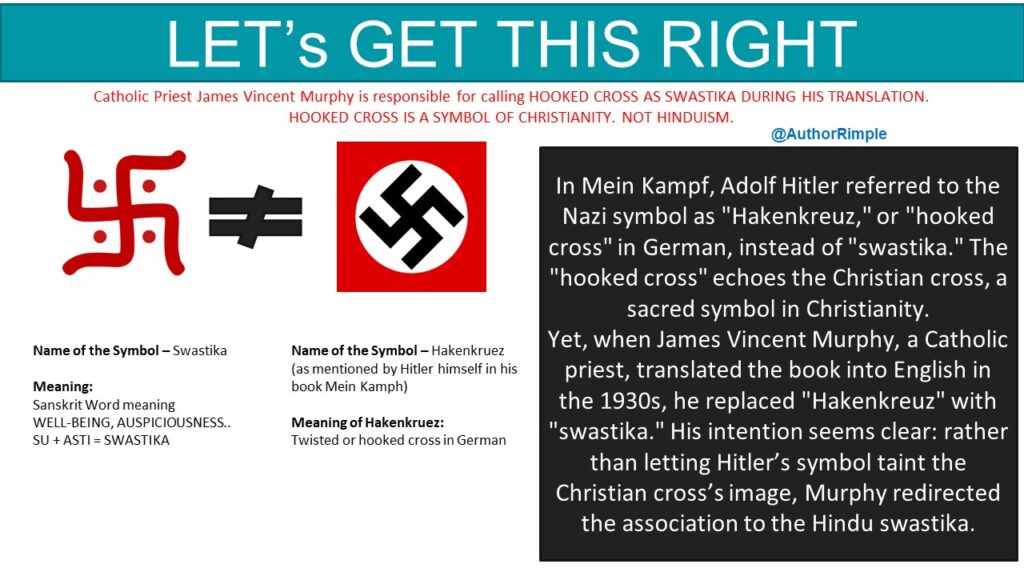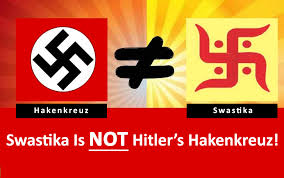
The Hindu Swastika: A Sacred Symbol of Well-Being
The Hindu swastika is an ancient symbol that has been part of Indian culture and Hindu traditions for thousands of years. It is deeply respected and holds a special place in religious and spiritual practices. The word “swastika” comes from Sanskrit, the language of traditional Hindu texts. In Sanskrit, “swastika” is made of two words: “su” (meaning good or well) and “asti” (meaning to be), so it literally means “well-being.” For Hindus, the swastika stands for prosperity, good fortune, and auspiciousness.
Shape and Design: The Hindu swastika is a simple cross with four arms of equal length, each arm bending at a right angle. It can face either right or left, depending on the tradition, and both directions are considered sacred.
Meaning: It represents positive energy, the cycle of life, and the movement of the sun. It’s a symbol of harmony and balance in the universe.
Use: You’ll see it drawn on doors, temples, or during ceremonies like weddings and festivals to bring good luck and blessings.
Science Behind It: In Hindu belief, the four arms can symbolize the four Vedas (ancient scriptures), the four stages of life, or the four directions, showing a connection to nature and existence.
The Nazi Hakenkreuz (hooked cross): A Twisted Symbol of Hate
The Nazi symbol does not mean swastika originally. In his book Mein Kampf Hitler clearly mentions that his Nazi Party symbol is called the Hakenkreuz (hooked cross) in German, was adopted by Adolf Hitler and the Nazi Party in the 20th century. Unlike the Hindu swastika, this is a cross, though now it is called Swastika. This version is a distorted and rotated form that became a symbol of racism, violence, and destruction during World War II. Hitler took an ancient symbol and changed its meaning completely for his own dark purposes.
Shape and Design: The Nazi hooked cross (misunderstood as Swastika) is tilted at a 45-degree angle, making it look like it’s spinning or slanted. The arms are hooked in a way that gives it a sharp, aggressive appearance, usually facing right. It’s most often seen in black inside a white circle with a red background.
Meaning: For the Nazis, it stood for their ideas of racial superiority and power. It has no connection to the original positive meaning of the Hindu swastika.
Use: It was used on Nazi flags, uniforms, and propaganda to spread fear and control, especially during the Holocaust.
Why Hitler Chose the Hakenkreuz
Hitler was fascinated by ancient symbols and myths, and he chose the “Hakenkreuz,” or “hooked cross,” as the Nazi emblem. This hooked cross is a symbol in Christianity where Jesus Christ is hooked on Cross, call it crucifixion. Some also say he encountered this symbol through German nationalist groups who tied it to their distorted notion of an “Aryan” past (a fabricated historical concept). Inspired by its bold, ancient form, Hitler adapted the hooked cross—tilting it and giving it a sharp, aggressive look—to match his ideology of hate and power. Unlike the Hindu swastika, which he didn’t directly reference, his version was meant to evoke a Germanic heritage, twisted in both design and purpose to serve the Nazi agenda.
Key Differences Between the Hindu Swastika and the Nazi Swastika
The Hindu swastika and the Nazi hooked cross may look somewhat similar at a glance, but they are worlds apart in meaning, history, and design. Here’s how they differ:
Age: The Hindu swastika is thousands of years old, dating back to ancient India. The Nazi hooked cross misunderstood as Swastika was created in the 1920s by Hitler’s party.
Purpose: The Hindu version is about peace, luck, and well-being. The Nazi hooked cross misunderstood as Swastika is about war, hate, and oppression.
Appearance: The Hindu swastika is upright and simple, while the Nazi hooked cross misunderstood as Swastika is rotated 45 degrees and often bold and harsh-looking.
Context: Hindus use it in prayers and celebrations. Nazis used it as a political tool for terror.
How Hitler Hijacked the Symbol
Hitler didn’t invent the swastika, but he stole it from ancient cultures and gave it a new, ugly meaning. For him it was never Swastika but always a hooked cross.
Before the Nazis, the swastika was used in many places—like India, Europe, and even Native American art—as a sign of good things. Hitler saw it in Austrian and German groups that were obsessed with a fake “Aryan” history. He liked its bold shape and thought it could represent strength for his Nazi Party. By rotating it and putting it on a red flag, he made it his own, stripping away its sacred roots.
The Hindu swastika remains a symbol of light and hope for millions.
The Nazi hooked cross misunderstood as Swastika is a reminder of a dark time—proof that the same shape can mean very different things depending on who uses it and why.
Hitler’s Use of “Hakenkreuz” and the Translation Twist
In Mein Kampf, Adolf Hitler called the Nazi symbol “Hakenkreuz,” meaning “hooked cross” in German, rather than “swastika.” The term “hooked cross” could hint at Christian imagery, like the cross, but Hitler used it to craft a distinct German symbol for his ideology, separate from its ancient origins. When James Vincent Murphy, a Catholic priest, translated Mein Kampf into English in the 1930s, he swapped “Hakenkreuz” for “swastika.” This raises suspicion: Did Murphy intentionally link it to the well-known swastika of Hindu tradition to distance it from Christian symbolism? By doing so, he may have deliberately shifted focus away from any “hooked cross” connection to Christianity, muddling Hitler’s term with the ancient, sacred Hindu symbol and creating confusion that persists today.
CONCLUSION
Hitler’s Nazi Party Symbol is a HOOKED CROSS…. NOT SWATIKA… It was a deliberate attempt of a Catholic Priest James Vincent Murphy he swapped “Hakenkreuz” for “swastika” to taint the image of Hinduism sacred ancient symbol and protect the image of Christianity symbol of hooked cross where Jesus Christ was Crucified!!!!






